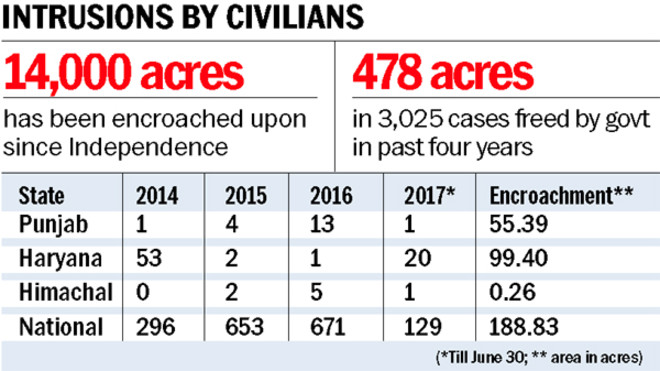
Vijay Mohan
Tribune News Service
Chandigarh, August 19

With growing demand and shrinking open areas in the vicinity of cities and towns, there has been a progressive increase in encroachments and unauthorised constructions on defence land over the past few years.From 296 cases across the country in 2014, the number went up to 653 and 671 over the next two years. Till June 30 this year, 129 new cases were reported, involving a total area of 188.83 acres over the past four years.(Follow The Tribune on Facebook; and Twitter @thetribunechd)In Punjab, only a single case of encroachment had come to the notice of authorities concerned in 2014. In 2016, this figure rose to 13, according to officially available figures. In the past three years, there have been a total of 19 cases involving 55.39 acres of land. While Haryana had just two cases in 2015, there have already been 20 cases so far this year, bringing the area encroached upon in the past three year to 99.4 acres. In 2014, the number had been 53, the third highest among all states in the country. The hill state of Himachal is also witnessing a similar phenomenon, although the area of land involved is relatively small at just 0.2 acres. With no case being reported in 2014, the number went up to two in 2015 and five in 2016.More than 14,000 acres of defence land has been encroached upon since Independence and the issue had also reached the Supreme Court in the form of a public interest litigation seeking remedial steps by the government. In the past four years, the government has managed to free 478 acres in 3,025 cases. The reasons cited for encroachments and unauthorised constructions include vast spread of defence land, increased pressure on land, title disputes and continued occupation of the land leased for agriculture or commercial activity even after the expiry of leases. Difficulties have been faced in the timely renewal of leases on account of absence of renewal application with full documents, violation of leased terms or non-mutation due to disputes. The defaulters include not only private players but even central and state government agencies.
